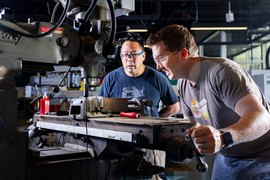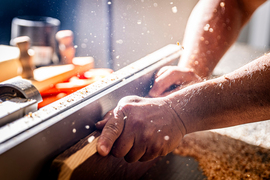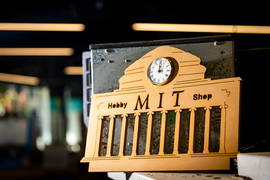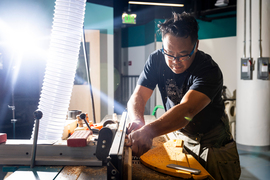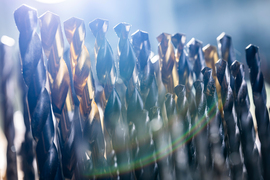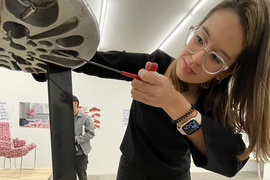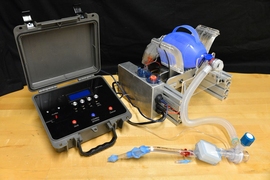For 85 years, MIT’s Hobby Shop has provided a space for MIT’s community members to build their passion projects. For the last 65 of those years, that work has taken place in a low-ceilinged, windowless room in the basement of Building W31. Now the Hobby Shop is opening in a new location on Massachusetts Avenue that’s sure to increase its visibility — not to mention the sun exposure of its users.
The new MIT Hobby Shop, which officially opens tomorrow in Building N51, features new and upgraded machinery as well as an additional 1,000 square feet of workspace. In fact, if not for some durable equipment and the familiar faces of Hobby Shop Director Hayami Arakawa and Technical Instructor Coby Unger, the shop would be virtually unrecognizable.
“It’s super different,” says MIT Space Administrator Greg Raposa, who helped orchestrate the move. “The floor plan before was sort of a narrow rectangle. The new floor plan is a large, wide-open space with an office in the center. It’s more visible from the street, and it’s much brighter. They’ve got everything they need now, including a new welding setup, and we’re collecting sawdust in the back of the building. It’s what you would build if you’re going to build a hobby shop from scratch.”
The Hobby Shop is arguably MIT’s most democratic makerspace on campus: Students, professors, alumni, and staff can begin booking time on machines as soon as they’re finished with safety training. The reservations are first come, first served, in contrast to other makerspaces on campus that prioritize class projects or are only open to students from specific departments.
“The shop was founded by students who wanted to work on their hobbies and projects of their own personal interest as opposed to academic work,” Arakawa says. “By and large we’ve kept that spirit. Whatever your personal interests, we provide the space, machinery, and materials needed to refine your idea and work on it without time restraints or grades. We don’t give assignments here.”
Most projects make use of the shop’s woodworking equipment, although it also has metal working tools, CNC machines, a welding room, and 3D printers. Arakawa says many people build pieces of furniture that serve as gifts.
“MIT’s motto is ‘mind and hand’; we add heart into that,” Arakawa says. “It’s not just about getting something hacked together to show proof of concept. It’s about building something a little more refined, so it’s a much more finished product at the end of the day.”
People who frequent the shop say its welcoming mantra gives it a more supportive, community feel.
“Because it’s not tied to a class or school it has the widest range of people of any makerspace on campus,” says Robin Willis SM ’23, who frequented the old space and helped the Hobby Shop design its new orientation process this summer. “Some shops are only available to mechanical engineering or architecture students, but the Hobby Shop is for everyone: staff, students, alumni, anyone who needs it. It’s also a really friendly environment. If you have questions or want to know what someone’s working on, they’re usually really excited to tell you about it, because it’s a personal project.”
The Hobby Shop’s move was first conceived of about three years ago and came to fruition as after the MIT Museum moved to a new building in Kendall Square last year, opening up the first floor of its old home in N-51, which had served as the museum store.
“We had always dreamed of moving the Hobby Shop out of there when there was an opportunity,” Raposa says. “We were also looking to get someone into the [old museum’s] first floor to keep that area of campus a vital part of community.”
“The architects really wanted to make this a very lively space as far as visuals go,” Arakawa says. “I think they accomplished a good 90 percent of what we suggested.”
Some pieces of equipment were simply moved into the new space, but most were either refurbished or replaced, including five machines in the wood shop. In some cases, the Hobby Shop was able to trade equipment with other labs and departments in MIT. They also received donated equipment as other groups were upgrading and were able to purchase equipment through funds raised from an enthusiastic donor base.
“Having been around for 85 years, I wanted to build a shop that would last another 100 years,” Arakawa says. “Some of the machines were completely rebuilt. They can’t make them like they used to.”
The Hobby Shop should also benefit from its proximity to other shops. Makers will be a short walk or a flight of stairs away from the School of Architecture’s wood shop as well as makerspaces run by D-Lab, the Edgerton Center, the MIT Morningside Academy for Design, and the MIT Electronics Research Society (MITERS).
Nowadays everyone involved in the move is excited to welcome MIT’s community to its new maker home — and everyone is talking about the natural light of the new space.
“There were days in the winter where I’d go into work in the dark and I’d come out and it’s dark again — Not anymore!” Arakawa says. “We’ll definitely be more high-profile. We have a lot of people already from the general population of Cambridge coming through asking, ‘What’s this?’”
The shop holds 30-minute tours on Tuesdays at 1 p.m. It will also host a celebration of its new location on Saturday, Sept. 30. Beyond that, Arakawa is simply excited to get back to work.
“The students keep us going, and there’s really never a dull moment here,” Arakawa says. “There’s never a day without at least half a dozen or a dozen projects going on. Whether they’re old members or brand new, I am 100 percent confident people will love this space.”
